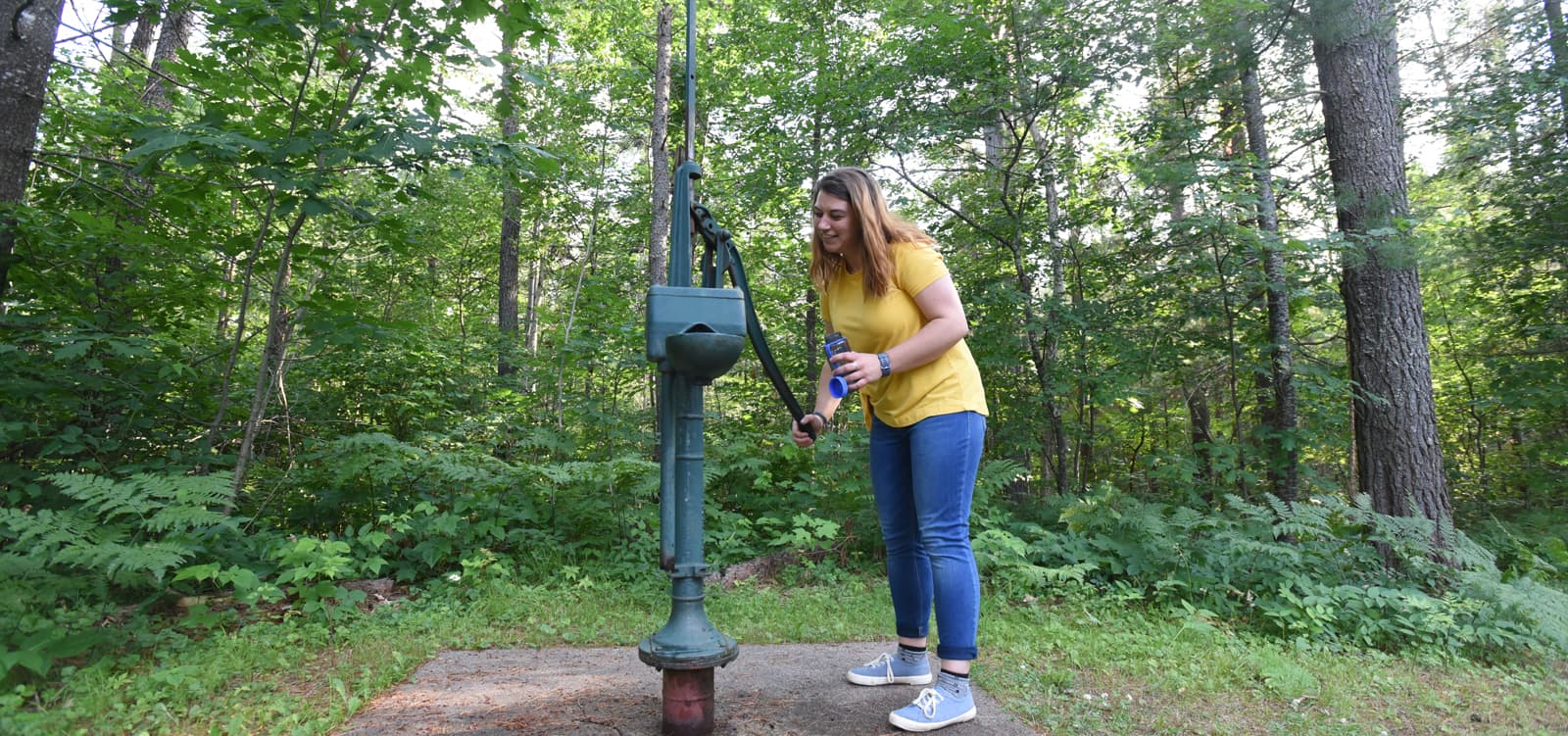
Primitive Camping in the Northern Highland American Legion State Forest
August 24, 2020
Campers who are looking for a more secluded experience on their camping trip may choose between two types of primitive campsites, canoe or remote-reservable, or skip a developed campsite altogether and do a little backcountry camping. Primitive campsites are generally widely dispersed with a minimal clearing and a primitive soil surface. Facilities at primitive campsites are limited to a tent clearing, fire ring, box wilderness latrine and a picnic table.
Canoe campsites
The Northern Highland American Legion State Forest (NHAL) offers canoeists the opportunity to camp along rivers and lakes at designated canoe campsites. There are currently 74 canoe campsites located on more than 20 lakes and rivers across the NHAL. To use these sites, campers must access them by watercraft. Stays are limited to one night only with no more than six people to a site. Sites are marked with yellow signs displaying a tent. No campsites reservations accepted. No fee is required. Trash must be packed out. A maximum of six people are allowed per campsite.
Remote reservable campsites
The NHAL has 17 remote-reservable primitive campsites. They are on Allequash, Day, Nebish, Clear Lakes and in the Bittersweet Wild Lakes Area. They are accessible only by water. These sites may be occupied up to 14 nights per visit. Regular nightly camping fees apply. These sites may be reserved from May 1 through Labor Day. After Labor Day these sites are available on a first-come, first-served basis. A maximum of six people are allowed per campsite.
Allequash Lake remote reservable campsites
Allequash Lake is found between Minocqua and Boulder Junction east of Highway M in Vilas County. There is no development on this lake except for the boat landing. Sites here are large enough for two small tents each, and are far apart from each other. Each site has a picnic table and stone fire ring. An open-air toilet is located nearby.
Bittersweet Wild Lakes Area remote reservable campsites
There are five sites on four different lakes, Prong Lake, Smith Lake, Oberlin Lake and Bittersweet Lake, which are referred to as the “Bittersweet Wild Lakes Area.” The largest of the four, Bittersweet, is found northeast of Minocqua, north of Highway 70. Use caution, the road to the boat launch parking lot is rough and a four-wheel drive vehicle is recommended. “Sunken Rowboat” site is on Prong Lake. “Big Rock” and “Trappers Cabin” sites are on Bittersweet Lake. “Loon Song” is on Smith Lake and “Sunset Point” is on Oberlin Lake. All campsites have a tent pad, picnic table and stone fire ring.
Day Lake remote reservable campsites
Day Lake is an electric motors only lake located south of North Creek Road between Highways M and H in Vilas County. There are two campsites on this lake approximately 150 yards apart. Each site has a tent pad large enough for two small tents and a picnic table. Open-air toilets are located nearby. The motor restriction and distance from a paved road make these sites quiet and isolated.
Nebish Lake remote reservable campsites
Nebish Lake in Vilas County is approximately three miles east of Highway M. Entrance to the campsites is on Nebish Lake Road found directly across from the Trout Lake Forestry Headquarters on Highway M. There are two sites on Nebish. Both sites have picnic tables, stone fire ring and an open-air toilet located nearby. There is no development on Nebish Lake except for the boat landing. This lake is an experimental research lake so visitors must register at the fish checking station at the Escanaba Lake boat landing before and after each fishing day. See fishing regulations for more details on the special rule.
All these remote sites are on the Wisconsin State Parks Reserve America under “Northern Highland American Legion State Forest – Crystal Lake Area.”Campers should register at the Crystal Lake Ranger Station before heading out to their campsite.
Maps of Remote Reservable Campsites
Backcountry camping
Your interest in backcountry camping indicates you enjoy nature, seek solitude and enjoy the challenge of roughing it. As one who appreciates the forest environment, you are cordially welcome to the state forest. The NHAL is a “working forest,” managed for scenic beauty, recreation, wildlife, clean water and timber. You may come upon timber sales or other management activities during your trip. If you would like more information on these activities, please don’t hesitate to ask questions of any of our staff.
Backcountry camping regulations
- Camping is limited to 14 nights and no more than six individuals or one family. Juvenile groups are an exception. You must move your camp every night.
- Have an idea where you would like to camp before applying for your permit. Camping is not allowed within sight of any trail or body of water. Campsites must be at least one half mile from your vehicle.
- Practice Leave No Trace low impact camping:
- Plan ahead. An unprepared camper creates a higher risk for impact.
- Travel on durable surfaces. Avoid stream banks and wetlands.
- Dispose of waste properly. Pack out what you bring in. Wash dishes and answer nature’s call at least 200 feet from the trail, camp or any water source. Cover solid human waste with forest duff.
- Minimize fire impact. Keep fires small and make sure they are dead out before leaving the campsite.
- Respect wildlife. Observe animals from a distance and never feed them. Once a squirrel or bear gets a taste for human food, they actively seek them out, which can lead to dangerous behavior.
- Be considerate of other visitors. Keep noise levels down. Remember we’re all trying to enjoy a finite resource.
- Good campsites are found, not made. Altering the campsite should be unnecessary.
